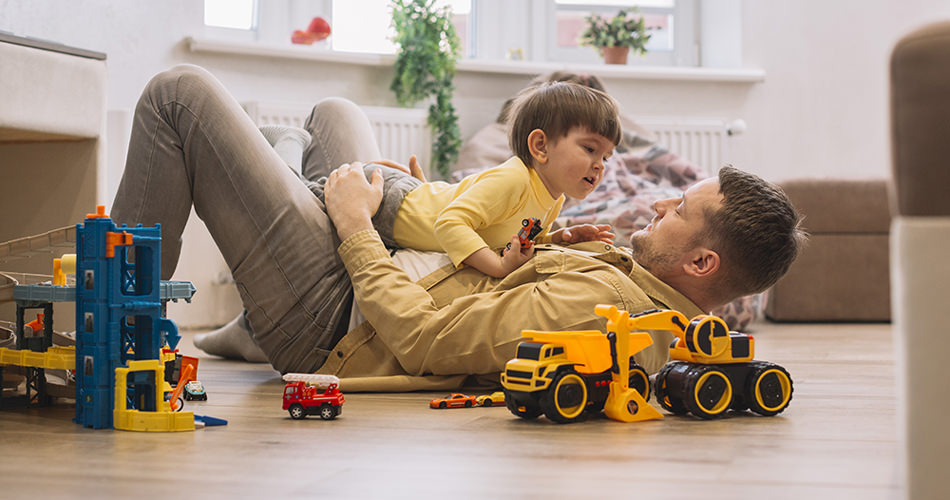
Play is a child’s work and It’s a healthy activity that helps children’s all aspects of their development. And, it offers a chance to interact with others. Especially with their parents. Parents are the child’s first teacher and that teaching happens through the play. Play helps your children to learn the rules of family and what is expected of him or her. As children grow, play helps them to learn how to interact with society.
“Play is the work of childhood”
Jean Piaget
Parents need to make time to play with their children and usually, children start to play from their infant stage. When the infant starts to smile with their parents, they should smile back. Play is directed by the child and reward also comes to the child. Play is an enjoyable and spontaneous action. Moreover, play helps to learn social and motor skills and cognitive thinking processes.
Play is needed for healthy development for children. most of the research shows that seventy-five percent (75%) of brain developments occur after birth. Thus, play helps with that development by stimulating the brain through the formation of a connection between nerve cells. Not only that, but this process also helps with the development of fine and gross motor skills. Fine motor skills are activities such as being able to hold a crayon and a pencil. Gross motor skills are activities such as jumping and running.
In addition, Play helps to develop language and socialization skills. Playing allows children to learn how to communicate with emotions, thinking, and problem-solving.
Playing with children builds a lasting bond and it allows parents to appreciate and recognize the uniqueness of each child. When a parent or sibling plays a game with a child, they learn to share their toys and activities. they try to teach how to work those toys. It helps to enhance their self-importance and positive social interaction. Therefore, Child’s self-esteem gets a boost and this feeling is sending a positive message to your child. and, they try to develop a vision of the world and gain a sense of their place in the family and in society.
Therefore, Family activities are very important for the child and it helps to develop a strong present and future family bond which can last a time.
Types of Play
There are many types of play. They are,
- Unoccupied Play
- Solitary Play
- Onlooker Play
- Parallel Play
- Associative Play
- Social Play
- Motor-Physical Play
- Constructive Play
- Expressive Play
- Cooperative Play
Let’s discuss each of these types of play below.
Unoccupied Play
Unoccupied play type starts in the early month of infancy, from birth to about three months. Your child is busy in unoccupied play. Children seem to be making random movements with no clear purpose, but this is the initial form of playing.
Solitary Play
Solitary play starts from three to eighteen months, and babies will spend much of their time playing on their own. During solitary play, children are very busy with play and they may not seem to notice other children sitting or playing nearby. They are exploring their world by watching, grabbing, and rattling objects. Solitary play begins infancy and is common in toddlers. This is because toddlers limited social, cognitive, and physical skills. However, it is important for all age groups to have some time to play by themselves.
Onlooker Play
Onlooker play happens most often during the toddler years, but it can take place at any age. This is where the child watches and learns other children’s play. Moreover, children are learning how to relate to others and learning the language. Although children may ask questions of other children, there is no effort to join the play.
Parallel Play
Parallel Play starts from 18 months to two years. Children begin to play alongside other children without any interaction. This is called parallel Play that provides your toddler with opportunities for role-playing such as dressing up and pretending. It also helps children gain an understanding of the idea of property rights such as “mine”. They bring to show their need for being with other children their own age. Parallel Play is usually found with toddlers, although it happens in any age group.
Associative Play
When your children are around three to four years of age, they become more interested in play with other children than toys. At this stage, your child has slowly started to socialize with other children. This play is sometimes referred to as “loosely organized play”. In addition, this type of play helps preschoolers to learn the dos and don’ts. Moreover, this play teaches the art of sharing to children, encourages language development, enhances problem-solving skills and cooperation. In associative play, groups of children have similar goals. They do not set rules, although they all want to be playing with the same type of toys and may even trade toys. There is no formal organization.
Social Play
Children around the age of three are beginning to socialize with other children and by interacting with other children in play settings. Therefore, your child learns about social rules such as how to give, take, share, and cooperate with others. under this type of plays, Children can share their toys and ideas. not only that, they are beginning to learn to use moral reasoning to develop a sense of values. But, to be prepared to function in the adult world, children should experience a variety of social situations according to the proper time and developmental stages.
Motor-Physical Play
When children run, jump, and play games such as hide and seek, they engage in physical play that offers a chance for children to exercise and develop muscle strength. When children engage in physical activities, it helps to teach social skills and gives enjoying good exercise. Moreover, your child will learn to accept winning or losing.
Constructive Play
In this type of play, Children create many things. Constructive play starts the infancy period and it becomes more complex according to the child development stages. As a Toddler, children begin building some structures with Building blocks and other toys, playing with sand, and drawing paintings with colors also based on this constructive play. Constructive play allows children to explore objects and discover patterns to find what works and what does not work. In addition, this play type helps to gain self-pride when accomplishing a task. Moreover, they can develop confidence in their mind to manipulate a variety of objects, create new ideas, and to work with numbers and concepts.
Expressive Play
Some types of play help children to learn and to express their feelings. And their parents can give many different materials like paints, crayons, colored pencils, and marker pens for drawing pictures or writing shapes and letters. It can also include such items as clay, water, and sponges to experience different textures. Rhythm instruments are other sources of toys for expressive play. You can take an active role in expressive play by using these materials alongside your children.
Cooperative Play
Cooperative Plays begin in the late preschool period. This play is organized by group goals. There is at least one leader and children are in or out of the group. When children move from a self-centered world to an understanding of the importance of social contracts and rules, they begin to play games with rules. Part of this development occurs when they learn games such as following the leader. As an example, Simon says, and team sports help to develop the objective of these types of games. And, these types of games and their rules teach children the concept that life has rules that everyone must follow.
Benefits of Play
There are many benefits of Play.
Children gain knowledge through their play. They learn to think, remember, recall, and solve problems and It gives children the opportunity to test their beliefs about the world. They can enhance their problem-solving abilities through games and puzzles. They can strengthen their language skills by modeling other children and adults.
In addition, playing houses help to create stories of their life roles, such as ‘I am the Mother or I am the teacher, etc.”. Children also imitate their own family and school experiences. This helps children to learn about the different roles in the family and society.
Play helps children to be creative while developing their own imaginations and It is very important to healthy brain and cognitive development of children. Play is the first opportunity for your child to discover the world in which he or she lives, and play offers a child the ability to master skills that will help develop self-confidence and the ability to recover quickly from setbacks. As an example, a child may feel pride in stacking blocks and disappointment when the last block makes the stack fall. under these experiences, Play allows children to express their views, experiences, frustrations, and emotions. A complete guide to playtime for kids is very important for every parent. It can help the children in their emotional, social and physical development part.
some types of plays help children to learn how to be a part of the group, to learn the skills of negotiation, problem-solving, sharing, and working with others. Moreover, Children can learn how to make a correct decision, how to move at their own pace and to discover their own interests during the play.
The play will be important when your child enters school. Because basically, it can assist children in adjusting to the school setting, enhance children’s learning readiness and their cognitive development by allowing them to move forward from subjects and other extracurricular areas without the fear of failure.
Playtime in school such as recess time, it allows learning and practicing of basic social skills. At that time, Children develop a sense of self, learn to interact with other children, make new friends, and the importance of role-playing.
Conclusion
According to these explanations, the play is an essential and critical part of all children’s development. It starts in the child’s infancy stage and ideally, continuous throughout his or her life. Play is the best way to learn how to socialize, how to think, how to solve problems, how to mature and most importantly how to have fun and, the play connects children with their imaginations, environment, family, and the world.
References
- Kamenetz, Anya (2018), 5 Proven Benefits Of Play, retrieved on 12, March, 2020 from https://www.npr.org/sections/ed/2018/08/31/642567651/5-proven-benefits-of-play
- Rock, Amanda (2020), 11 Types of Play Important to a Child’s Development, retrieved on 12, March 2020 from https://www.verywellfamily.com/types-of-play-2764587
- Scott-McKie, Louise and Casey, Theresa, (n.d) Play types Toolkit, retrieved on 12, March, 2020 from https://www.playscotland.org/wp-content/uploads/Play-Scotland-Play-Types-Tooolkit-bringing-more-play-into-the-school-day.pdf
- Vitor, Silva (2019), The Importance of Play in Child Development, retrieved on 10, March, 2020 from https://www.builtbyme.com/importance-play-in-child-development/
- Why play is important, raisingchildren (The Australian parenting web site), retrieved on 10, March, 2020 from, https://raisingchildren.net.au/newborns/play-learning/play-ideas/why-play-is-important
- Why play is important, Play England, retrieved on 12, March, 2020 from https://www.playengland.org.uk/about-us/why-play-is-important/




